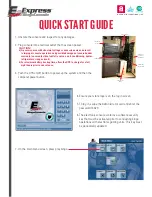
7. Behaviour in case of damage
If damage is found during the inspection of the rescue system, the parachute must be sent to the manufacturer for
assessment/repair. This also applies to damage whose effects on the airworthiness of the system cannot be clearly
determined.
Caution: Chemicals, cleaning agents, insects, mould stains and the like can have just as negative an effect on the strength
of the components as mechanical damage.
8. Storage
Oils, greases, acids and paints must not be stored in the immediate vicinity of the parachute. The room should be dry.
Parachutes which are not used for a longer period of time must be opened, the canopy rolled up loosely and stored in an air-
permeable carrier bag.
High temperatures above 60° C, such as can occur in a car parked in the sun, must be avoided!
9. Maintenance
The service life and condition is highly dependent on the care of the user. We therefore recommend that the rescue system
is regularly inspected for signs of wear and damage, at the latest when it is repacked.
In normal use, pay attention to the following:
If the rescue equipment has become damp or wet, it must be opened as quickly as possible and dried in a well-ventilated
place - but not in the sun - and then repacked to avoid mildew and mould.
If the rescue system has been used beyond its normal service life, it must be sent to the manufacturer for inspection. (e.g. if
the rescue system has been subjected to mechanical pressure or a sharp object may have caused damage.).
Avoid contact with salt water, acids or other aggressive substances!
Exposure to sunlight should be avoided as ultraviolet radiation weakens the molecular structure of the material.
10. Cleaning
Dirty canopies and containers can be cleaned carefully with clean tap water and a soft sponge.
Attention: Under no circumstances may chemicals, brushes, hard sponges or similar be used for cleaning! Cleaning in the
washing machine is also not permitted.
If the rescue system has been in contact with salt water, rinse it with plenty of fresh water. Rinsing and cleaning accelerates
the ageing process of the material.
11. Repairs
Repairs must be carried out only by the manufacturer or by a company authorised by the manufacturer.
12. Nature and environment friendly behaviour
Please practise our sport as much as possible in a way that preserves nature and the landscape! Do not go off the marked
trails, do not leave any rubbish behind, do not make unnecessary noise and respect the sensitive biological balances in the
mountains. Especially at the launch site, consideration for nature is required!
13. Environmentally compatible waste disposal
At the end of the life of the rescue parachute, it must be disposed of in an environmentally friendly manner. We are happy to
take care of this when the rescue parachute is returned.
14. Spare parts / changeable parts
Besides the rubber bands, no spare part is necessary for the NG / NG light series. Only tested rubber bands of the size
25x3x1 mm may be used! They can be purchased from us at a reasonable price..
The deployment bag is an integral part of the rescue parachute, except when using an inner container described under No
18.4. and must not be exchanged for a third party brand. Otherwise the operating licence will expire!
The deployment bag is made of nylon fabric and has a 4-point closure.
On the deployment bag there are 3 loop possibilities for the deployment handle of the outer container or for the deployment
handle of the harness.
The frontcontainer (optional) is made of robust, water repellent Nylon fabric. It consists of 2 lateral flaps, the upper and
lower flap, the release handle with 2 pins, which closes the container.
15. Structure of the parachute
The parachute has a square construction and consists of 20 panels. Packing loops are attached to the top of the canopy.
The canopy is made of high strength nylon fabric. The seams of the canopy are cap seams. Hem and canopy are
reinforced with sewn-in tapes. The lines are sewn to the canopy and the line connections on the canopy are reinforced
with V-tapes. The centre of the canopy is drawn in over flares and centre lines. All lines and centre lines are connected to
the bridle.
The connecting line has a strength of > 2400 daN.
release handle
opened frontcontainer with Y-bridle
backside of the frontcontainer,
with instrument deck
loop in point
release handle
Bridle
Suspension
lines
Canopy
Overview
Flares
4
5

































